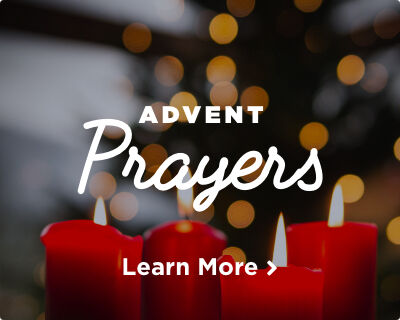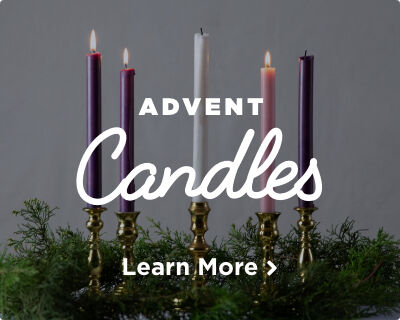
Catholic Advent and Christmas Traditions
People celebrate Christmas in many different ways, but some Christmas traditions can be found all over the world. Each of these traditions has a unique story and a unique way of reflecting the real meaning of Christmas. And many of the common traditions we love today are rooted in our Catholic faith!
Advent Feast Days and Solemnities
Where Did the Christmas Tree Come From?
Why Do We Decorate with Lights?
What is a Nativity Crèche?
A nativity crèche, also known as a nativity set or manager scene, is a set of figures who were present in Bethlehem during Jesus' birth. Traditionally this includes the baby Jesus, Joseph and Mary, shepherds, angels, magi, and a variety of farm animals. Nativity crèches come in all shapes and sizes. Some are small and can fit on a table. And some churches do live nativity scenes with people and live animals participating as the figures. The first nativity scene was created by St. Francis of Assisi in 1223.
Setting up a nativity crèche allows us to reflect on the humble beginnings of our salvation all Advent season. Catholics traditionally hide the figure of baby Jesus and only add him to the scene on Christmas Day. This is a great visual way to help young children understand what we prepare for during Advent.
Advent Feast Days and Solemnities
A feast day is a day in which we honor the life of a particular saint. This is typically their birth or death date. A solemnity celebrates an important aspect of our Catholic faith. The traditions of feast days and solemnities that fall during Advent and Christmas can add joy to your preparations!
December 6: Feast of St. Nicholas
How to Celebrate St. Nick's Feast Day: Children leave a pair of shoes or a stocking out to receive candy or small gifts from St. Nicholas
December 8: Solemnity of the Immaculate Conception
How to Celebrate the Solemnity of the Immaculate Conception: This is a Holy Day of Obligation, so Catholics should attend Mass. We celebrate the Catholic doctrine that Mary was conceived completely free of original sin. One way to honor the day is to sing Marian songs like “Ave Maria.”
December 13: Feast of St. Lucy
How to Celebrate St. Lucy's Feast Day: Lucy comes from the Latin word lux which means light. She is a very popular saint in Sweden. On the morning of December 13th, the oldest daughter wears all white and a crown with candles and serves a sweet treat like saffron buns to the rest of the family.
Christmas Solemnities
January 1: Solemnity of Mary, Mother of God
How to Celebrate the Solemnity of Mary, Mother of God: This is also a Holy Day of Obligation, so Catholics should attend Mass. We can also pray a rosary as we start the new year.
January 6: Solemnity of the Epiphany
How to Celebrate Epiphany: The Epiphany is the last of the twelve days of Christmas. It’s the day we celebrate the arrival of the magi who worshiped Jesus. There are many ways to celebrate this final day of Christmas. Some give gifts. Some eat King’s Cake, which has a hidden figure of baby Jesus inside. And some bless their home by using blessed chalk to write 20 + C + M + B + 23 over the front door. 20 is the first two numbers of the year, the three letters stand for the three magi named in the Bible (Caspar, Melchior, and Balthasar), and 23 is for the last two numbers of the year.
Where Did the Christmas Tree Come From?
For thousands of years, the evergreen tree has been a sign of hope and life. For ancient people, it was a reminder in the winter that sunlight and good weather would come again. For Christians, it's a reminder that Jesus came to bring us the hope of eternal life.
While sixteenth century Germans are said to be the first people to bring Christmas trees into their homes, St. Boniface, an eighth century Catholic missionary to the Germans, is credited with creating the first Christmas tree. This happened one Christmas Eve when he chopped down a large oak tree that the Germans used for pagan worship. He pointed to a nearby evergreen tree, saying that it represented peace and eternal life. He told the crowd of Germans to gather around evergreen trees in their homes in a spirit of kindness and love, to commemorate the child Jesus.
In the early 1800s, German settlers brought the Christmas tree tradition to Pennsylvania. The rest of America adopted the tradition in 1846, and slowly but surely the Christmas tree gained popularity. Now, Christmas trees are seen in homes and on display all over the world. Their beauty and light remind us of the hope we have in Jesus.
Sign Up for Best Advent Ever
Join us and receive an inspirational video each day of Advent!
Why Do We Decorate with Lights?
Candles and lights are prevalent at Christmas time. Glowing warmly at the darkest time of year, they symbolize the light of Jesus shining through the darkness of sin and death.
Today’s strings of electric Christmas lights evolved from candles. It’s not clear when candles first became a Christmas tradition, but one historical record mentions that a large candle was used in the Middle Ages as a symbol of the star of Bethlehem.
During the 1500s, Christians began using candles to decorate their Christmas trees. The flickering glow of the small flames amid the evergreen branches created a beautiful image of hope, but it was a fire hazard. In 1882, Thomas Edison’s friend Edward H. Johnson created the first string of electric Christmas lights, making it much safer for people to light their trees.
Advent and Christmas Traditions Around the World
Christmas is a joyous celebration in the Catholic faith, observed with unique traditions around the world. In Germany and Austria, Catholics celebrate St. Barbara’s feast day in a special way. On December 4th a small cherry branch is cut and put into a vase in a warm room. The branch typically blooms right around Christmas - and if the blossoms arrive on December 25, it’s considered good luck! This tradition aligns perfectly with Advent, the season of anticipation for the birth of Jesus. It serves as a symbolic reminder of the hopeful expectation and joyous blooming that accompanies his arrival.
A common tradition in Mexico and some other Latin American countries is the celebration of Las Posadas, which means “The Inns.” This is a nine-day event where the community processes to symbolize Mary and Joseph’s search for an inn in Bethlehem. The march is made mostly of children with one dressed as an angel leading the procession. Each night Mary and Joseph travel through the neighborhood or town and ask for lodging. They are denied - but the host provides refreshments! Christmas carols are sung. On the final night Mary and Joseph are welcomed and a feast is held. Children break open pinatas filled with candy and small toy
In the Philippines, a unique tradition called Simbang Gabi is observed during Advent. It is a series of nine early morning Masses held from December 16th to 24th, often starting at 4AM! These Masses serve as a preparation for Christmas and are often followed by festive meals and gatherings. It is believed that if one completes all nine Masses, their wish or prayer will be granted.
Light is a common symbol for the birth of Jesus. In Ireland a candle is traditionally placed on a window sill after sunset on Christmas Eve. The candle continues to burn all night to symbolize a welcoming light for Mary and Joseph.
In the United Kingdom St. Stephen’s Day, or Boxing Day, is celebrated on December 26. This day is dedicated to the martyr St. Stephen who was known for his acts of service. The name “Boxing Day” comes from the tradition of giving money and gifts to servants in Christmas boxes.
Why Do We Exchange Gifts?
When Jesus was born, there were wise men, or magi, who came from distant lands to worship him. They offered him gifts of gold, frankincense, and myrrh. One reason we give gifts at Christmas time is to follow the example of the magi. We also follow in the example of the generous St. Nicholas.
Giving gifts is also a way to remember how, on that first Christmas night in a stable in Bethlehem, God gave us the greatest gift of all—his only son, who would die for our sins about three decades later. When we give gifts at Christmas, it is a wonderful opportunity to give of ourselves, imitating God’s amazing generosity and showing his love to others.
Learn More About Advent
Looking for more inspiration this Advent season? Join us for Best Advent Ever!







